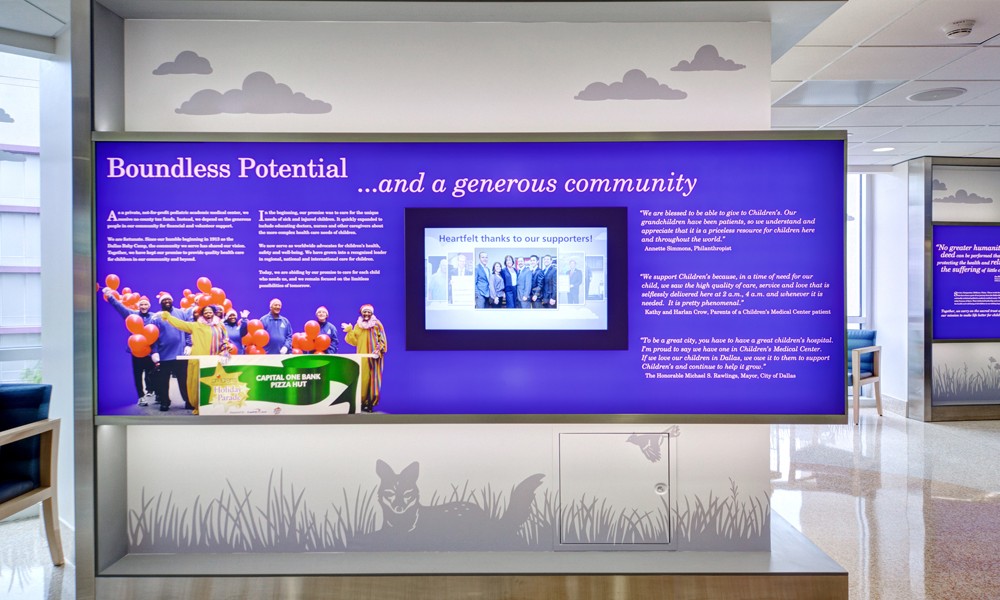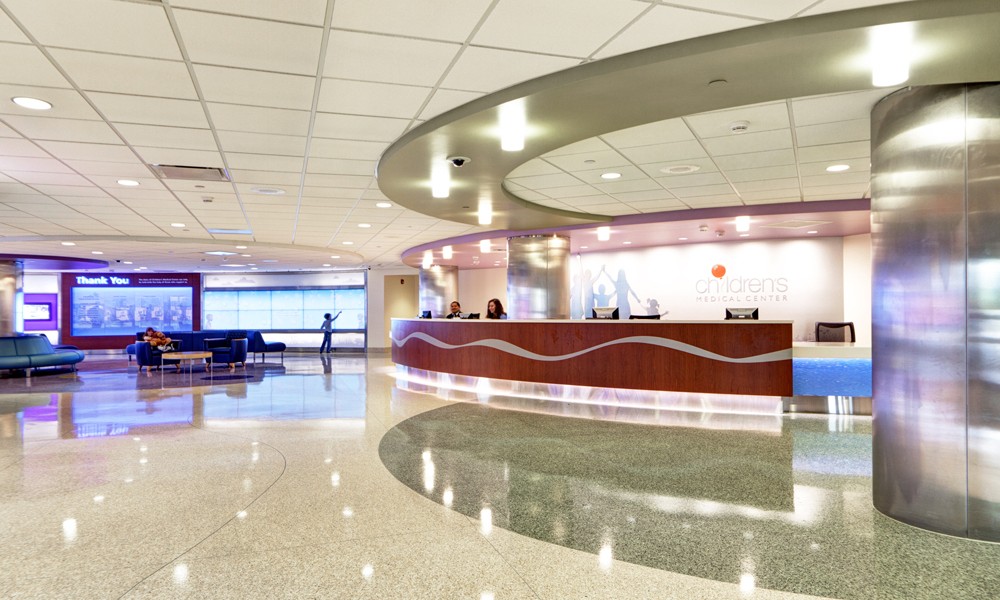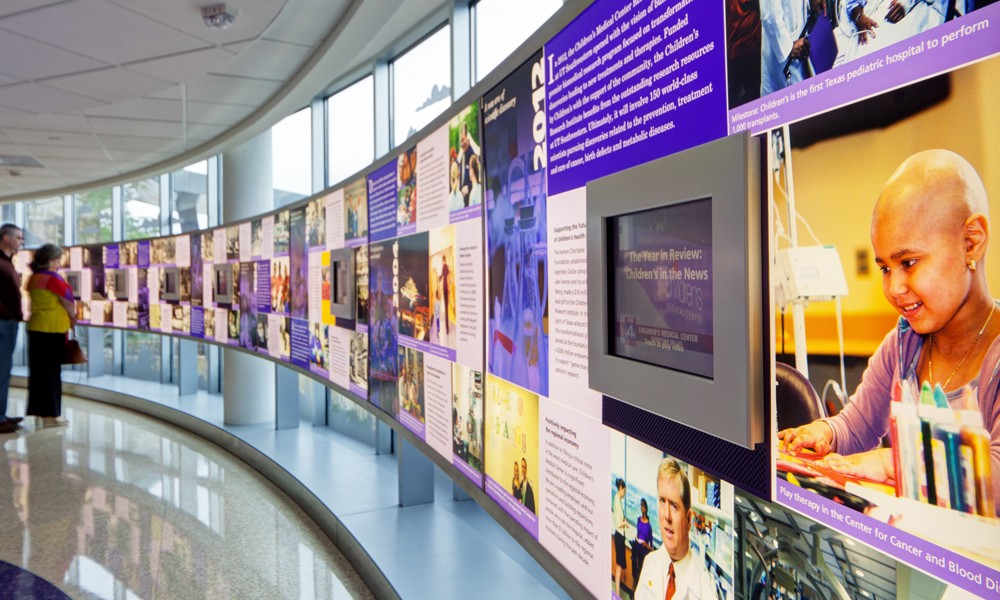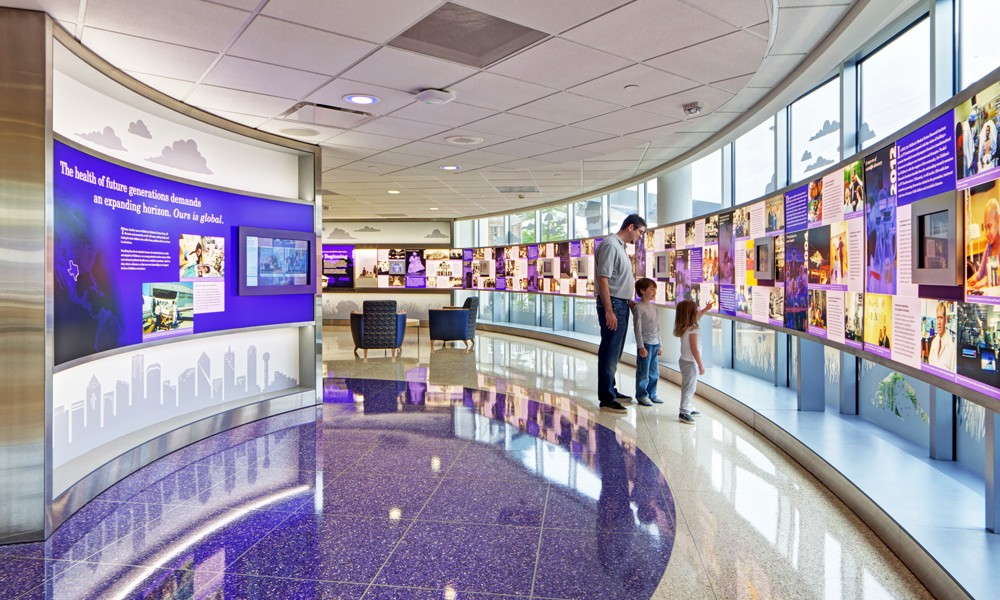 Interactive touch screens integrate Children’s Medical Center Dallas’ visual storytelling with playful illustrative graphics.
Interactive touch screens integrate Children’s Medical Center Dallas’ visual storytelling with playful illustrative graphics.  The welcome desk is prominently visible from the main entrance, while the interactive donor wall provides a fun and engaging experience for children and families.
The welcome desk is prominently visible from the main entrance, while the interactive donor wall provides a fun and engaging experience for children and families.  An interactive timeline chronicles Children’s Medical Center Dallas’ storied history.
An interactive timeline chronicles Children’s Medical Center Dallas’ storied history.  Children interact with an immersive Centennial Celebration Exhibit.
Children interact with an immersive Centennial Celebration Exhibit. Subscribe Now
Children’s Medical Center Dallas Commemorates 100 Years of Care with New Lobby
By Rachel Windham | Images by Chad M. Davis, AIA
Children’s Medical Center Dallas, nationally recognized as one of the Best Children’s Hospitals of 2013-2014, recently celebrated a landmark 100-year anniversary. One of the milestone events was the grand opening of the newly renovated main lobby, featuring a permanent centennial exhibit that celebrates the hospital’s storied history and dedication to children.
Because the lobby is visited throughout the day by a mix of young patients, families, hospital staff and community members, the functional layout and the exhibit content had to meet a variety of needs.
“With a distinct story intended for visitors, donors and employees, the challenge was integrating each journey in an intuitive, informative and interactive manner,” explained Judson Orlando, director of planning, design and construction for Children’s Medical Center.
The team of WHR Architects and West Office Exhibition Design were up to the challenge. WHR and Children’s have enjoyed a close relationship in recent years, working together to develop an “Interior Branding and Wayfinding Master Plan” to strengthen the organization’s brand identity and create a more intuitive wayfinding experience for the campus. West Office Exhibition Design, a design studio, joined the team bringing to the project its expertise in creating engaging exhibits and immersive environments.
WHR led the design effort for the project using Children’s vision statement of “Refined Whimsy” as the defining concept for the overall lobby renovation. The concept is expressed via simple sophisticated forms, a fresh, modern color palette and design elements featuring fanciful renditions of the Dallas skyline, animals, nature and, of course, children.
The exhibits tell the rich, 100-year history of the hospital, the realization of the vision articulated for Children’s by founder Nurse May Smith from its humble beginning in the Spring of 1913 as the Dallas Baby Camp to the world-class hospital and academic medical center it is today.
Smith’s vision was made possible through the dedication of the Dallas community to provide healthcare for all children – regardless of ability to pay.
“To honor the donors, the exhibit has a permanent donor recognition wall and an easily updatable video wall for annual donors,” said Steve Wiersema, principal of West Office Exhibit Design. “This video wall presents the names of the donors rising up on virtual bubbles that are blown by an on-screen boy and girl; the larger the bubble, the larger the donor contribution. Visitors can disturb the path of the bubbles by walking along the wall, or they can select from a menu to find a specific donor name.”
This exhibit and other programs are designed for easy updating by staff to assure that new donors and new hospital stories can be displayed with relative ease.
Among the challenges the team faced in designing an exhibit space, in particular, was the limitation of relatively low-ceiling heights due to some existing building infrastructure issues. To help alleviate the problem, the design team kept ceiling features very simple and used a strong horizontal band of illuminated graphics at eye-level that help offset the lower ceilings and make the space feel more expansive. The exhibit structures feature layered panels of wood and etched glass, illustrative storybook-like graphics and color-changing LED lighting that frame the informational displays of the center’s history, expertise and leadership.
“Though the exhibit messages are mostly for adults, the landscape illustration provides a fun opportunity for children to try to find animals hiding around the exhibit space,” noted Wiersema.
Intuitive design and consideration of the patient and family journey played a strong role in the redesign of the lobby — the reception desk was relocated to be highly visible from all lobby entry points and serves as a critical orientation point. Behind the desk, a welcome wall features the hospital’s logo complete with a signature red balloon, surrounded by sophisticated silhouettes of children that convey feelings of happiness, camaraderie and fun.
The various exhibit nodes are carefully positioned to provide a sense of discovery within the lobby public space — an open and flowing layout of layered translucent materials, colorful graphics and circular pod-like shapes. The circular, embracing form of the exhibits is repeated in the flooring patterns, ceiling elements and seating arrangements. The interior finishes are simple, modern and inviting. Bright and engaging, the entire space reinforces a message of care and concern for young patients that is explicit in the remarkable history on display in the exhibit.
Rachel Windham, IIDA, SEGD, LEED AP, is an associate with WHR with more than 13 years of interior design experience on healthcare projects. Her background includes all aspects of interior design, from visioning and concept design, programming and documentation, to furniture selection and installation. She has a special focus on intuitive design and wayfinding and understands the key impact that interior design has on shaping and influencing the perceived healthcare experience.
Tags: Architecture, Construction
Posted September 18, 2013
More Articles:
- IFMA’s Facility Fusion Conference & Expo
May 5, 2024 – May 7, 2024 - ASHE Academy 2024
May 6, 2024 – May 10, 2024 - World Conference on Quality & Improvement
May 12, 2024 – May 15, 2024 - ACEC Annual Convention & Legislative Summit 2024
May 13, 2024 – May 16, 2024 - 2024 Annual Clinical & Scientific Meeting
May 17, 2024 – May 19, 2024 - CleanMed 2024
May 21, 2024 – May 23, 2024 - Hospital, Outpatient Facilities & Medical Office Buildings Summit
May 22, 2024 – May 22, 2024











